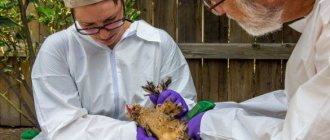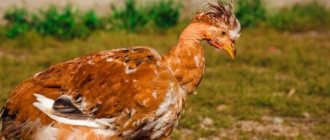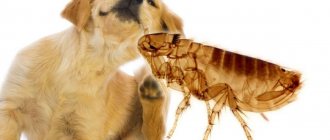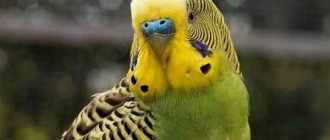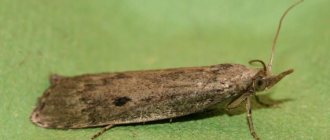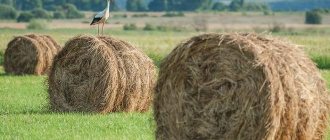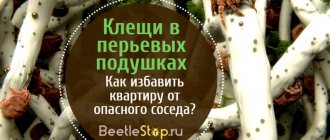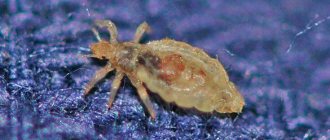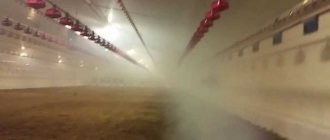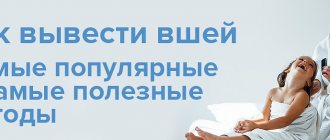But who are lice? These blood-sucking insects are small in size, making them difficult to notice. Lice bites are accompanied by severe itching, so that some scratch the scalp until it bleeds. You should be wary if this happens.
The fertility of female lice is relatively low: daily - 4 eggs, total - up to 140. They attach to the hair closer to the scalp, where it is warm for the eggs to hatch - for this reason, lice require a hair length of 3-4 mm.
What do chicken lice look like?
These are small insects of a dark brown or yellow-brown color, no more than half a centimeter in size (usually about 2 millimeters). The body of chicken lice has a flattened shape, with claws at the ends of the legs. On the head there is a proboscis, with the help of which parasites feed on blood, and mandibles (jaws). It is difficult to see insects among the plumage with the naked eye.
Chicken lice reproduce by laying eggs. After emergence, the louse grows quickly and within a few days it becomes capable of reproducing. Insects live for about a month, feeding on the blood of the bird, scales of the hostess’s skin, as well as down and feathers. There are many different subspecies of chicken lice.
Preventive actions
It is not always possible to prevent the invasion of mallophages. But if you pay due attention to prevention, the risk of parasite infection can be reduced to zero.
To prevent livestock from becoming infected with chicken lice, you need to:
- Place containers filled with a mixture of fine sand and ash in the chicken coop. Birds should always have the opportunity to take dust baths.
- Protect the poultry house from rodents (mice, rats).
- Do not allow domestic chickens to come into contact with wild feathered relatives (sparrows, pigeons, crows).
- Regularly clean the shed and the surrounding area, frequently change the bedding and remove droppings, and control the humidity level in the room.
- Carry out antiparasitic treatment of the chicken coop and the entire livestock 1-2 times a year.
- Wash and disinfect feeders and drinkers weekly.
- After visiting someone else's poultry house, change clothes and shoes so as not to carry larvae or adult mallophages.
- Periodically inspect chickens for the presence of feather eaters. If parasites are found on at least one chicken, disinfest the entire flock and the chicken coop.
- In the autumn-winter period, add vitamin and mineral supplements to the feed to help strengthen the birds’ immunity.
Newly acquired laying hens should not be allowed into the chicken coop without prior antiparasitic treatment with chemical or folk remedies.
How to get rid of chicken lice?
If feather-eating parasites are detected, it is not recommended to delay the start of treatment. It is necessary to immediately treat the chicken coop (the birds are transferred to another place), and then begin to rid the chickens of lice.
In an advanced stage, treatment is carried out with medications; at earlier stages, folk remedies give a good effect.
Pharmacy drugs
The necessary medications are purchased at a veterinary pharmacy. In order to remove parasites, it is recommended to use:
- Sprays (Clean House, Frontline, Beafar). Before starting application, it is necessary to clean the surface of the chicken from any contamination. Then the treatment is carried out over the entire body of the bird against the feathers, which need to be lifted until the skin is exposed. You need to spray the bird until it becomes wet. It is important to ensure that the spray does not get into the chickens’ beaks or eyes. Products such as Stomazan, Neostomaza and oxamate emulsion are contraindicated for laying hens and should not be used 30 days before slaughter.
- Drops (Frontline, Bars). Depending on the area of infection, the product is applied either to the entire body of the chicken, or only to the withers of the bird. In this case, the drops should not fall on the feathers, but on the skin of the chicken, for which the feathers must be carefully pulled apart. Drops should not be used more than once a month. The use of such products on chickens and sick chickens is prohibited. Drops are added to a warm drink for young animals.
- Aqueous solutions (Tetrix, Executioner, Butox). They are applied similarly to sprays by spraying the skin of chickens. For the treatment of chickens, Promectin is recommended, which is diluted with water and poured into drinking bowls.
- Special powders (Deltamethrin). Such products are rubbed into the skin of chickens.
See also
Description of the best treatment methods and for what reasons chickens fall on their feetRead
Any procedure is carried out twice. The second time - 1-1.5 weeks after the first.
Without parallel treatment of the chicken coop, treating chickens will be pointless. The room where the birds are kept must be thoroughly cleaned and washed, and then sprayed with insecticides. In this case, there should be no birds in the chicken coop for 2 hours after treatment. When working with the product, it is recommended to wear special clothing, a mask and gloves. After two weeks, the treatment is repeated.
For spraying the chicken coop, it is recommended to use Peritrum, Karbofos, Butox, Sevin, Drucker, Diazinon, Tsifox, Entomozan Super, as well as some products that are used to treat the birds themselves (for example, Butox). Solutions must be prepared strictly according to the instructions.
If possible, spraying with insecticides can be replaced by steam treatment of the chicken coop.
It is carried out using a special unit, or by calling special services that have the necessary devices.
It’s a good idea to use insecticidal smoke bombs (Peshka-B) to disinfect the chicken coop. Treatment should be carried out in the absence of birds. One checker is intended for 250 cubic meters of space.
Before you let the birds into the chicken coop, you need to lay out new bedding, add fresh food and pour clean water. To repel parasites, herbs such as tansy, wild rosemary, wormwood or chamomile are scattered.
Folk remedies
Usually used in the earliest stages of the disease. To remove lice, vinegar, kerosene (alone or mixed with gasoline and alcohol), and herbal decoction are used:
- Vinegar is diluted with cold water in a ratio of 1:3 and sprayed on the chickens using a spray bottle.
- Kerosene is used in the same way, only it is not diluted with water. To repel ticks, you can add a little ammonia to kerosene and apply a few drops of this product to the back of the chicken’s neck.
- It is recommended to make a mixture of kerosene, alcohol and gasoline in equal proportions. This mixture is rubbed into the skin of chickens.
- A decoction of herbs is prepared as follows: take 300 grams of tansy, chamomile and wild rosemary, pour 6 liters of boiling water, cook for 15 minutes. Allow to cool and spray the birds with this product.
See also
Types of diarrhea in chickens and symptoms of diarrhea, how to treat at homeRead
In addition to the products used, you can use sand-ash baths.
They are also good as a preventive measure. A container with sand and ashes is placed on the territory of the pen or chicken coop, and the chickens themselves will fuss there. Sometimes purified sulfur is added there (bought at the pharmacy).
Traditional methods of treatment
There are many recipes in folk medicine to get rid of parasites
- • Table vinegar. The acid helps dissolve the sticky substance of the nits, making them much easier to comb out. To obtain a solution, apply 9% vinegar to the hair and scalp twice a day and leave for up to 30 minutes, after which the hair is rinsed with clean water.
- • Kerosene. Due to its oily base, the substance clogs the respiratory system, which causes the death of parasites. The advantage is that kerosene is effective both against adults and in the fight against nits. But the method is toxic and should be used no more than once a week.
- • Essential oils have a distinct odor, which also repels lice
- • Wormwood and tansy. To obtain the composition, you need to pour twenty grams of the herb into a glass of boiling water, after 20 minutes you can additionally heat the composition in a water bath. The solution is applied to the hair and left for several hours.
- • Tar soap. In addition to the pungent odor, it has an irritating effect. You should use it to wash your hair no more than 3 times a week. After this, the hair needs to be dried and combed out to remove dead parasites.
What products should not be used?
Some remedies help against chicken lice, but harm the bird itself. Others do not cause harm to birds, but accumulate in muscle fibers and eggs, after which, when they enter the body of people, they cause intoxication.
To remove chicken lice, the use of endrin, chloradane, heptachlor, benzene, and hexachloride is prohibited.
When using approved chemicals, it is important to observe their dosage, since exceeding it can also affect the quality of chicken meat.
Effective treatment
Despite the large number of folk recipes, it is recommended to give preference to pharmaceutical products. They are safer for health and effective in fighting parasites. This is especially true for the treatment of head lice in children. The “Paranit” line of products has proven itself to be excellent.
The products contain dimethicone and mineral oil. As a result of application, the lice's spiracles become clogged, oxygen access is blocked, and then they die.
A wide range of products allows you to choose the optimal solution for getting rid of parasites for people of all ages.
The product not only quickly and safely eliminates insects, but also has a number of other advantages:
- • convenient to apply and easy to wash off;
- • is not addictive;
- • non-toxic and does not affect the children's body;
- • optimal volume – 1 bottle of the bottle is enough for several treatments, so there is no need to buy the drug for each family member;
- • the line includes products for pregnant women and babies up to one year old (“Paranit Sensitive”);
- • Available in several forms - lotion, shampoo and spray.
- • Regardless of which product is used, after treatment it is necessary to remove dead parasites from the hair. (“Paranit Sensitive” does not require additional combing after using the product).
Prevention
To prevent the appearance of parasites, it is necessary to take the arrangement of the chicken coop seriously. It should be spacious enough and have a fence that prevents sparrows and rats from getting in there. The chicken coop and aviary require regular cleaning.
Proper nutrition of birds also plays an important role. The food must contain all the necessary microelements, vitamins and minerals. When purchasing new individuals, you should definitely make sure that they are not infested with lice or carry out preventive treatment.
Symptoms of chicken disease
When the degree of infection is insignificant, fluff eaters practically do not make themselves felt: they do not affect the health, behavior and appearance of the carrier. But with intensive reproduction, the presence of parasites can be determined by the condition of the skin and plumage of chickens.
Typical symptoms of infection are:
Chickens infected with lice develop bald spots.
- ruffled feathers;
- inflammation, redness, wounds, scratching on the skin;
- holes on individual feathers;
- necrosis and peeling of individual areas of the epidermis;
- partial loss of feathers;
- baldness in the anal area, on the head, neck, chest and abdomen;
- swelling of the eyelids, clouding of the cornea, purulent discharge from the eyes.
Infection with mallophages is evidenced by the restless behavior of chickens, which constantly scratch their beaks and paws, trying to remove insects from themselves. When parasites actively multiply, laying hens suffer loss of appetite, decreased body weight, and exhaustion, which negatively affects egg production.
Infected chickens suffer the infestation even more severely - they grow slowly, show no interest in food and practically do not gain weight. If treatment is not carried out in time, infection with mallophages will cause the death of the bird.
Pediculosis incidence peaks in autumn and spring.
The following factors contribute to infection and rapid reproduction of parasites:
- poor livestock care;
- unsanitary conditions;
- dampness in the chicken coop;
- poor diet;
- keeping a large number of chickens in a cramped poultry house;
- lack of free range;
- ignoring preventive measures.
Chicken lice can also appear after contact between birds and wild birds or rodents that carry ectoparasites.
Laying hens should be kept in direct sunlight or an incandescent lamp for 10-15 minutes if lice are suspected or for a routine examination. Mallophages love warmth, so they will certainly crawl closer to the light source and be clearly visible. In laying hens, you need to examine the skin under the feathers in the most vulnerable places where there is a concentration of down feather eaters: on the neck, cloaca, belly, and skin under the wings.
